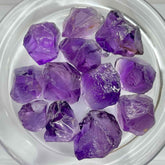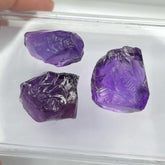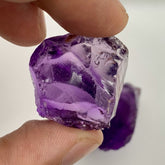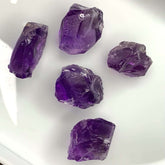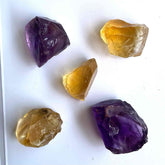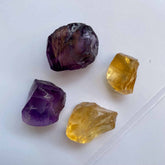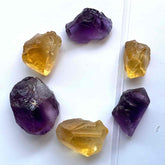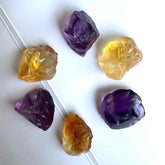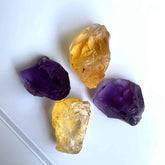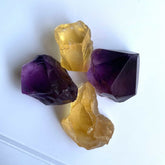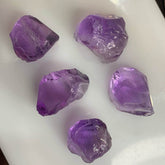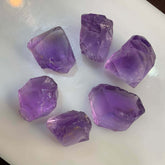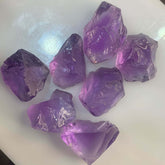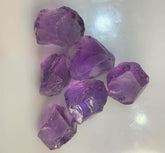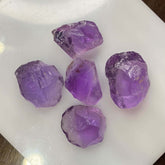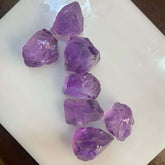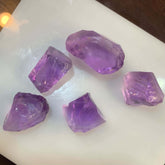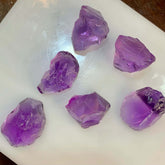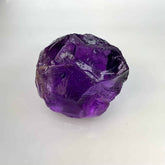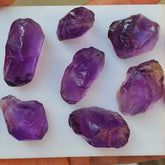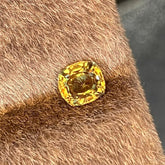Filter
38 results
30
- 10
- 15
- 20
- 25
- 30
- 50
Date, new to old
- Featured
- Best selling
- Alphabetically, A-Z
- Alphabetically, Z-A
- Price, low to high
- Price, high to low
- Date, old to new
- Date, new to old
Sort
Sort by:
- Featured
- Best selling
- Alphabetically, A-Z
- Alphabetically, Z-A
- Price, low to high
- Price, high to low
- Date, old to new
- Date, new to old
-
Purple Amethyst Facet Rough Parcel
Product Information: Rough Gemstone Purple Amethyst Facet Rough Parcel Weight 606.50 carats Average Weight 50.54 carats Clarity Eye Clean / Better No of Pieces 12 Treatment None Description: Amethyst is a variety of Quartz and is the world's most popular purple gemstone. Amethyst has...- $315.00
$325.00- $315.00
- Unit price
- / per
-
130 Carats Purple Amethyst Facet Rough Pieces
130 Carats Purple Amethyst Facet Rough Pieces is available for sale at wholesale price from Brazil. Product Information: Rough Gemstone Purple Amethyst Facet Rough Pieces Weight 130 carats Average Weight 43.33 carats Clarity Eye Clean / Better Origin Brazil No. of Pieces 03 Treatment...- $115.00
- $115.00
- Unit price
- / per
-
Buy 105 Carats Facet Rough Amethyst Duo
Buy 105 Carats Facet Rough Amethyst Duo which is for sale at wholesale price from Brazil. Product Information: Rough Gemstone Facet Rough Amethyst Duo Weight 105 carats Average Weight 52.5 carats Clarity Eye Clean Origin Brazil No. of Pieces 02 Treatment None Description: Amethyst...- $85.00
- $85.00
- Unit price
- / per
-
Magenta Purple Amethysts Facet Rough
Product Information: Rough Gemstone Magenta Purple Amethysts Facet Rough Weight 120.5 carats Average Weight 24 carats Clarity Eye Clean Origin Brazil No. of Pieces 05 Treatment None Description: Amethyst is a variety of Quartz and is the world's most popular purple gemstone. Amethyst has...- $95.00
- $95.00
- Unit price
- / per
-
Buy 102.70 Carats Facet Rough Amethyst and Citrine
Buy 102.70 Carats Facet Rough Amethyst and Citrine which is for sale at wholesale price with Eye Clean Clarity. Product Information: Rough Gemstone Facet Rough Amethyst and Citrine Weight (Citrine) 102.70 carats Weight (Amethyst) 117 carats Clarity Eye Clean Treatment None Description: Amethyst is...- $155.00
- $155.00
- Unit price
- / per
-
Buy 77.85 Carats Rough Amethyst and Citrine Couple
Buy 77.85 Carats Rough Amethyst and Citrine Couple which is for sale at wholesale price with Eye Clean Clarity. Product Information: Rough Gemstone Rough Amethyst and Citrine Couple Weight (Citrine) 77.85 carats Weight (Amethyst) 127.75 carats Clarity Eye Clean Treatment None Description: Amethyst is...- $145.00
$155.00- $145.00
- Unit price
- / per
-
Buy 132.20 Carats Rough Amethyst and Citrine Trio
Buy 132.20 Carats of Rough Amethyst and Citrine Trio which are for sale at wholesale price with Eye Clean / Better Clarity. Product Information: Rough Gemstone Rough Amethyst and Citrine Trio Weight (Citrine) 132.20 carats Weight (Amethyst) 157.45 carats Clarity Eye Clean / Better...- $205.00
- $205.00
- Unit price
- / per
-
Buy 27.90 Grams Mix Rough Amethyst and Citrine Lot
Buy 27.90 Grams Mix of Rough Amethyst and Citrine Lot which is for sale at wholesale price with Eye Clean / Better Clarity. Product Information: Rough Gemstone Mix Rough Amethyst and Citrine Lot Weight (Citrine) 27.90 grams Weight (Amethyst) 32.61 grams Clarity Eye Clean...- $210.00
$225.00- $210.00
- Unit price
- / per
-
Buy 32.61 Grams Facet Grade Rough Amethyst and Citrine
Buy 32.61 Grams Facet Grade Rough Amethyst and Citrine which is for sale at wholesale price with Eye Clean / Better Clarity. Product Information: Rough Gemstone Facet Grade Rough Amethyst and Citrine Weight (Citrine) 32.61 grams Weight (Amethyst) 26.05 grams Clarity Eye Clean /...- $205.00
- $205.00
- Unit price
- / per
-
Buy 27.21 Grams Mix Rough Amethyst and Citrine Pair
Buy 27.21 Grams Mix Rough Amethyst and Citrine Pair which is for sale at wholesale price with Eye Clean / Better Clarity. Product Information: Rough Gemstone Mix Rough Amethyst and Citrine Pair Weight (Citrine) 27.21 grams Weight (Amethyst) 38.36 grams Clarity Eye Clean /...- $230.00
- $230.00
- Unit price
- / per
-
Buy 47.8 Carats Eminence Amethyst Facet Rough
Buy 47.8 Carats Eminence Amethyst Facet Rough which is for sale at wholesale price from Brazil. Product Information: Rough Gemstone Eminence Amethyst Facet Rough Weight 47.8 carats Dimensions 21.5 x 19 x 16.5 mm Clarity Eye Clean / Better Origin Brazil Treatment None Description:...- $50.00
- $50.00
- Unit price
- / per
-
Buy 59.3 Carats Vivid Violet Amethyst Facet Rough
Buy 59.3 Carats Vivid Violet Amethyst Facet Rough which is for sale at wholesale price from Brazil. Product Information: Rough Gemstone Vivid Violet Amethyst Facet Rough Weight 59.3 carats Dimensions 31 x 17 x 16 mm Clarity Eye Clean / Better Origin Brazil Treatment...- $60.00
- $60.00
- Unit price
- / per
-
322.9 Carats Rich Purple Amethyst Facet Rough
Buy 322.9 Carats or 64.58 grams of Rich Purple Amethyst Facet Rough at wholesale price from Brazil useful for people with Crown Chakra, and Third Eye Chakra. Product Information: Rough Gemstone Rich Purple Amethyst Facet Rough Weight (in grams) 64.58 grams Weight (in carats)...- $260.00
- $260.00
- Unit price
- / per
-
Big Rose De France Amethyst Facet Rough Lot
Product Information: Rough Gemstone Big Rose De France Amethyst Facet Rough Lot Weight (in grams) 61.4 grams Weight (in carats) 307 carats Average Size 4.72 grams No. of Pieces 13 Origin Brazil Treatment None Description: Amethyst is a variety of Quartz and is the...- $153.00
$168.00- $153.00
- Unit price
- / per
-
Big Facet Rough Purple Amethyst Lot
295 carats of Big Facet Rough Purple Amethyst Lot is for sale at wholesale price from Brazil. Product Information: Rough Gemstone Big Facet Rough Purple Amethyst Lot Weight (in grams) 59 grams Weight (in carats) 295 carats Average Size 4.5 grams No. of Pieces...- $147.00
$165.00- $147.00
- Unit price
- / per
-
Facet Rough Amethyst Lot
27.75 grams of Facet Rough Amethyst Lot is for sale at wholesale price from Brazil. Product Information: Rough Gemstone Facet Rough Amethyst Lot Weight (in grams) 27.75 grams Weight (in carats) 138.75 carats Average Size 5.5 grams No. of Pieces 05 Origin Brazil Treatment...- $69.00
- $69.00
- Unit price
- / per
-
Facet Rough Rose De France Amethyst Lot
27 grams of Facet Rough Rose De France Amethyst Lot is for sale at wholesale price from Brazil. Product Information: Rough Gemstone Facet Rough Rose De France Amethyst Lot Weight (in grams) 27 grams Weight (in carats) 135 carats Average Size 3.85 grams No....- $67.00
$78.00- $67.00
- Unit price
- / per
-
Trendy Purple Amethyst Facet Rough Lot
Product Information: Rough Gemstone Trendy Purple Amethyst Facet Rough Lot Weight (in grams) 23.65 grams Weight (in carats) 118.25 carats Average Size 3.94 grams No. of Pieces 06 Origin Brazil Treatment None Description: Amethyst is a variety of Quartz and is the world's most...- $59.00
- $59.00
- Unit price
- / per
-
Rose De France Amethyst Facet Rough Lot
27.7 grams of Rose De France Amethyst Facet Rough Lot is for sale at wholesale price from Brazil. Product Information: Rough Gemstone Rose De France Amethyst Facet Rough Lot Weight (in grams) 27.7 grams Weight (in carats) 138.5 carats Average Size 4 grams No....- $69.00
$82.00- $69.00
- Unit price
- / per
-
Muted Purple Amethyst Facet Rough Lot
Product Information: Rough Gemstone Muted Purple Amethyst Facet Rough Lot Weight (in grams) 26.6 grams Weight (in carats) 133 carats Average Size 4.43 grams No. of Pieces 06 Origin Brazil Treatment None Description: Amethyst is a variety of Quartz and is the world's most...- $66.00
$78.00- $66.00
- Unit price
- / per
-
Viola Purple Amethyst Facet Rough Lot
25.8 grams or 129 carats Viola Purple Amethyst Facet Rough Lot is for sale at wholesale price from Brazil. Product Information: Rough Gemstone Viola Purple Amethyst Facet Rough Lot Weight (in grams) 25.8 grams Weight (in carats) 129 carats Average Size 5.16 grams No....- $64.00
$75.00- $64.00
- Unit price
- / per
-
Soft Purple Amethyst Facet Rough Lot
Product Information: Rough Gemstone Soft Purple Amethyst Facet Rough Lot Weight (in grams) 27.75 grams Weight (in carats) 138.75 carats Average Size 5.5 grams No. of Pieces 05 Origin Brazil Treatment None Description: Amethyst is a variety of Quartz and is the world's most...- $69.00
- $69.00
- Unit price
- / per
-
Dusty Purple Amethyst Facet Rough Lot
Buy 24.5 grams of Dusty Purple Amethyst Facet Rough Lot from Brazil which is for sale at wholesale price. Product Information: Rough Gemstone Dusty Purple Amethyst Facet Rough Lot Weight (in grams) 24.5 grams Weight (in carats) 122.5 carats Average Size 3.5 grams No....- $61.00
$75.00- $61.00
- Unit price
- / per
-
Facet Rough Purple Amethyst Lot
Buy 135 carats of Facet Rough Purple Amethyst Lot from Brazil which is for sale at wholesale price. Product Information: Rough Gemstone Facet Rough Purple Amethyst Lot Weight (in grams) 27 grams Weight (in carats) 135 carats Average Size 5.4 grams No. of Pieces...- $67.00
$80.00- $67.00
- Unit price
- / per
-
Warm Purple Facet Rough Amethyst Lot
Product Information: Rough Gemstone Warm Purple Facet Rough Amethyst Lot Weight (in grams) 22.57 grams Weight (in carats) 112.85 carats Average Size 3.76 grams No. of Pieces 06 Origin Brazil Treatment None Description: Amethyst is a variety of Quartz and is the world's most...- $56.00
- $56.00
- Unit price
- / per
-
364 Carats Purple Amethyst Facet Rough Lot
Buy 364 Carats Purple Amethyst Facet Rough Lot from Brazil with Eye Clean / Better Clarity is available for sale at wholesale rate. Its price is starting from $215. Product Information: Gemstone Name Purple Amethyst Facet Rough Lot Weight 364 carats Average Weight 45.5...- $215.00
- $215.00
- Unit price
- / per
-
73.90 Carats Big Size Intense Color Facet Rough Amethyst
Product Information: Gemstone Name Big Size Intense Color Facet Rough Amethyst Weight (in grams) 14.78 grams Weight (in carats) 73.90 carats Dimensions 27.8 x 26.9 x 18.5 mm Locality Brazil Clarity Eye Clean / Better Treatment None Shape Raw Description: Amethyst is a variety...- $60.00
$120.00- $60.00
- Unit price
- / per
-
104 Grams Mighty Facet Rough Amethyst Pieces
Buy 104 Grams / 520 CTS Mighty Facet Rough Amethyst Pieces from Brazil with Eye Clean Clarity and Raw Shape which is for sale at wholesale price. Its price is starting from $312. Mighty Facet Rough Amethyst Gemstones Name Facet Rough Amethyst Weight 104...- $310.00
$380.00- $310.00
- Unit price
- / per
-
13 Grams Vivid Purple Facet Grade Amethyst
Buy 13 Grams of Vivid Purple Facet Grade Amethyst from Brazil with Completely Clean Clarity and Raw shape which is for sale at wholesale price. Its price is starting from $65. This big and bulky Vivid Facet Grade Amethyst is from the mines of...- $62.00
$65.00- $62.00
- Unit price
- / per
-
19.64 Grams Big And Beautiful Facet Rough Amethyst
Buy 19.64 Grams of Big And Beautiful Facet Rough Amethyst from Brazil with Completely Clean Clarity and Raw shape which is for sale at wholesale price. Big And Beautiful Facet Rough Amethyst: Gemstones Name Facet Rough Amethyst Weight 19.64 Grams Dimensions 31 * 30...- $80.00
- $80.00
- Unit price
- / per
